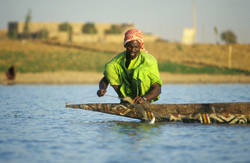Background

Mali is one of the poorest countries in the world. In 2013, it ranked 176 among 187 countries in the Human Development Index list of the United Nations. It has one of the lowest Gross Domestic Product (GDP) per capita in the world, which was about US$766 in 2014.
Agriculture is the backbone of Mali’s economy, accounting for about 42 percent of the country’s GDP and employing almost 72 percent of the work force of the country. Therefore, this sector has great potential of reducing poverty in the country. To do so, the agricultural sector will have to increase productivity levels, which are currently very low. The lack of productive infrastructure, especially for irrigation, the lack of investments in farm modernization, the very low usage of modern agricultural inputs and sustainable practices and the lack of coordination in the agricultural sector are the main drivers behind this low agricultural productivity.
Subsistance farming is the predominant form of agriculture in Mali. The country also exports certain crops, like cotton, but far behind its potential.
Mali has considerable irrigation potential. It has been estimated at about 2 200 000 ha, of which more than 1 800 000 ha in Niger River Valley. To date, 30 percent of that potential is under irrigation.
There are several constraints that have resulted in such underutilization of productive resources: the high costs of irrigation infrastructure, the limited technical capacities, the lack of funding, etc. However, with the Small-Scale Irrigation Promotion Programme developed by the Government of Mali, some of these constraints could be overcome.
The low productivity of the agricultural sector is one of the causes behind poverty in the country. The incidence of poverty is about 44 percent and is highest in rural areas, reaching 53.5 percent. Most rural poor depend on rainfed agriculture with low yields and strongly on weather variability.
